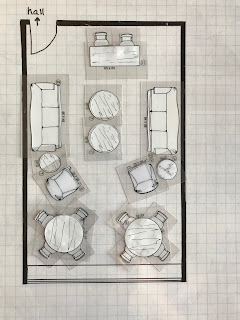Post 1/2 in the series How to Measure Your Room
Items you’ll need:
-Tape measure
-1/4” Graph paper
-Pencil
-Camera (phone will work just fine)
-Scale/ruler
- Furniture templates (optional)
I don’t know about you, but I cannot purchase a clothing item without knowing my measurements. If I blindly purchase a top without comparing my measurements to the retailers sizing chart, it is not likely the top will fit me. If this happens often enough, I am disappointed and left feeling unmotivated to make any purchases that update my wardrobe.
In that same way, it is impossible to create a great space without first stopping to take measurements (otherwise known as a space plan). The purpose of a space plan is to show you what size items can fit in your space. Having this guide helps you avoid purchasing pieces that are too large or too small. A space plan also serves as your first look at a layout. You can eyeball it on paper instead of moving furniture all around the room only to decide you don’t like how it looks. On paper, you can create as many possible layouts as you like before deciding on the final placement of your furniture.
Step One- Measure the room.
Using your pencil, I recommend quickly sketching the room on your graph paper. Don’t worry if it is to scale. You can measure overall length and width, but you’ll have to get even more specific to note exact placement of windows and doors. I tend to start in a corner of the room and work my way around by measuring each section. Be sure to note which way a door opens (into the room versus out of the room), as this will make a difference on where items can be placed. Once your room is drawn out, you can go back and make note of where outlets and vents are located. These notations will help you when it comes to placement later in the process. Go ahead and measure the ceiling height. You won’t need this immediately, but it’s good to note while doing all of your other measuring.
Your initial drawing will look like this, with each section of the room labeled with dimensions:
**DO NOT WORRY if yours is hand-drawn and a little messy at this point.
You will have the opportunity to clean it up.
I recommend snapping photos of each wall in the space to reference throughout the rest of the space planning process. Be sure to step back far enough that you can get the entire wall in your shot. You can always go back and take close up detail shots of anything you feel is important. An added bonus in snapping pictures is that you will have “before” photos to show people once your project is complete. Keep these in a place you can access remotely on your phone when out shopping- my personal favorite storage option is Dropbox.
Now it is time to make the drawing to scale. The reason behind drawing it a second time is to clean up any little errors made on the first drawing. I usually work in a ¼” scale which means ¼” on the paper = 1 ft in the room (and in the instance of ¼” graph paper- 1 square = 1 foot). This is a popularly used scale so you should have no trouble finding graph paper or furniture templates to accommodate you.
There are many ways you can go about the drawing- You can redraw by hand on your graph paper using your scale or ruler, you can use space planning software. This book comes with a ¼” graph printed on a dry erase material. It allows for easy erasing when mistakes are made. Using your tool of choice, draw out your room. If you want to be very precise, you can show your walls as 4.5” thick and fill them in, but that is not required.
If any of your furnishings will be staying in the room, be sure to measure the length, width and height of those items.



